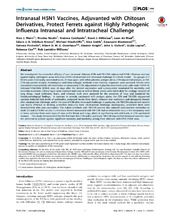Intranasal H5N1 vaccines, adjuvanted with chitosan derivatives, protect ferrets against highly pathogenic influenza intranasal and intratracheal challenge
Mann, Alex; Noulin, Nicolas; Catchpole, Andrew; Stittelaar, Koert J.; De Waal, Leon; Veldhuis Kroeze, Edwin J.B.; Hinchcliffe, Michael; Smith, Alan; Montomoli, Emanuele; Piccirella, Simona; Osterhaus, Albert D.M. E.; Knight, Alastair; Oxford, John S.; Lapini, Giulia; Cox, Rebecca Jane; Lambkin-Williams, Rob
Peer reviewed, Journal article
Published version

View/
Date
2014-05-21Metadata
Show full item recordCollections
Original version
https://doi.org/10.1371/journal.pone.0093761Abstract
We investigated the protective efficacy of two intranasal chitosan (CSN and TM-CSN) adjuvanted H5N1 Influenza vaccines against highly pathogenic avian Influenza (HPAI) intratracheal and intranasal challenge in a ferret model. Six groups of 6 ferrets were intranasally vaccinated twice, 21 days apart, with either placebo, antigen alone, CSN adjuvanted antigen, or TM-CSN adjuvanted antigen. Homologous and intra-subtypic antibody cross-reacting responses were assessed. Ferrets were inoculated intratracheally (all treatments) or intranasally (CSN adjuvanted and placebo treatments only) with clade 1 HPAI A/Vietnam/1194/2004 (H5N1) virus 28 days after the second vaccination and subsequently monitored for morbidity and mortality outcomes. Clinical signs were assessed and nasal as well as throat swabs were taken daily for virology. Samples of lung tissue, nasal turbinates, brain, and olfactory bulb were analysed for the presence of virus and examined for histolopathological findings. In contrast to animals vaccinated with antigen alone, the CSN and TM-CSN adjuvanted vaccines induced high levels of antibodies, protected ferrets from death, reduced viral replication and abrogated disease after intratracheal challenge, and in the case of CSN after intranasal challenge. In particular, the TM-CSN adjuvanted vaccine was highly effective at eliciting protective immunity from intratracheal challenge; serologically, protective titres were demonstrable after one vaccination. The 2-dose schedule with TM-CSN vaccine also induced cross-reactive antibodies to clade 2.1 and 2.2 H5N1 viruses. Furthermore ferrets immunised with TM-CSN had no detectable virus in the respiratory tract or brain, whereas there were signs of virus in the throat and lungs, albeit at significantly reduced levels, in CSN vaccinated animals. This study demonstrated for the first time that CSN and in particular TM-CSN adjuvanted intranasal vaccines have the potential to protect against significant mortality and morbidity arising from infection with HPAI H5N1 virus.
